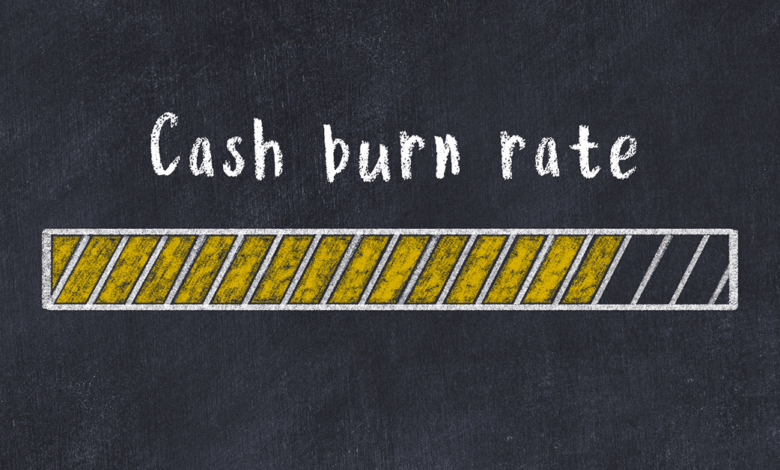
For early-stage startups, having cash is essential to staying afloat. But it’s one thing to have money and another to know how to spend and manage it. According to CB insights, 29% of startups fail because they run out of cash. That’s where the importance of cash burn comes in.
Understanding the burn rate of your startup and learning how to manage and monitor your cash runway is an essential element for survival and growth in the business world. Here’s why startups should pay special attention to their burn rate.
Burn Rate Measures Startup Longevity
A burn rate is essentially the rate in which a startup or company uses its cash, and indicates how a company is spending its funding to finance overheads before generating revenues from its operations.
Think of cash burn like the hourglass that measures how long your company has before it runs out of money. So, unless you want to risk spending too much too fast, you’ll want to pay attention to that cash flow.
To calculate your burn rate for a specific time, deduct your current cash balance from your starting cash balance. If your company, for example, started with $1M in the bank and spends $100k a month, its burn rate would be $100k.
[Burn Rate = Starting Cash Balance – Cash Balance in Current Month/in a specific period]

Cash runway is the metric that determines how long your cash will last at your current burn rate – basically how long your company has before it runs out of money if the burn rate remains constant. Your cash runway is your cash reserves divided by your monthly burn rate.
[Cash Runway = Starting Cash Balance / Burn Rate]
Going back to the previous example, if you have $1M in your cash reserves, and your burn rate is $100k per month, you will run out of cash in 10 months ($1M divided by $100k).
Cash runway is a significant concern for venture-backed startups who are using the cash to build the business, as they either need to become cash flow-positive or close another funding round before they run out of money.
The cash runway metric is also being used to measure how fast mature businesses are growing their cash reserves or whether they are investing that money to fund more rapid growth.
Why is Cash Burn important:
It helps you anchor startup expenses.
Cash burn affects a company’s financial runway and the amount of money it has in the bank. Startups can manage their burn rate by monitoring their cash flow, the metric that shows how much money you’re making versus how much money you’re spending. When monitoring your cash flow, you should identify where to reduce expenses and operating costs to prolong your financial runway.
Affects investors’ decisions
Burn rate identifies a company’s likelihood to enter financial distress. Your burn rate performance can affect your next investment round in many ways. It could prompt investors to either inject more capital into a company so that it starts generating revenues, or set specific deadlines for startups to make revenues. If you spend aggressively, you risk running out of money and losing your cash reserves before you make enough progress in raising another investment round.
Not all high burn is bad.
A high burn rate is not always a red flag. For fast-growing startups, a strategic burn rate that aims at gaining market share, winning customers and generating higher profits is essential for growth and attracting investors than a lower burn rate.
When cash burn is alarming.
Let’s take a look at Buenos Dias – a fictional startup as an example. Buenos Dias started with a net cash balance of $10 million in its first year in business. In the first half, the startup spent large amounts on operating activities, office spaces, corporate travels and salaries.
At the end of the first half, Buenos Dias’ cash balance was $7 million, meaning that the net cash burned by the startup amounted to $3 million – a burn rate of roughly $500,000 per month.
Assuming Buenos Dias has no other cash reserves, and its monthly burn rate remains constant, the startup’s runway is 14 months. Buenos Dias will have to take measures to reduce their burn rate, find additional sources of funding, or worst-case scenario cut their losses and seize operations.
How to reduce the cash burn rate?
There are many measures startups can take to reduce their burn rate and avoid running out of cash. Companies can work on increasing their revenues, getting more prospects into their funnel, generating more sales and raising their pricing. Other measures can include reducing operation costs, containing monthly expenses, reducing salaries, deferring new hires and cutting all costs that aren’t contributing to their success.
Businesses go to great lengths every day to control their expenditures and increase their revenues. Understanding how cash burn rate works, analyzing unit economics and cost of growth can help companies make informed decisions about the money they need to raise to cover their burn rate and achieve their goals. Learning to be strategic about how you’re spending your money ensures your success and sustainable growth.
Startups’ founders need Tribal’s spend management dashboard to help them spend wisely, set spending limits and monitor how every dollar is spent so that they are always in control of their expenses.



